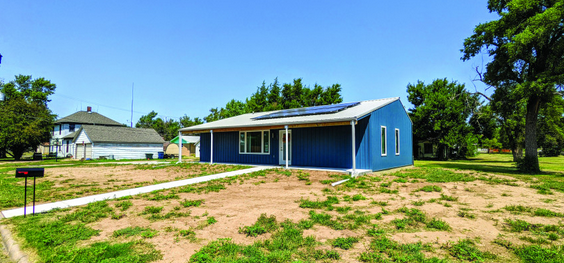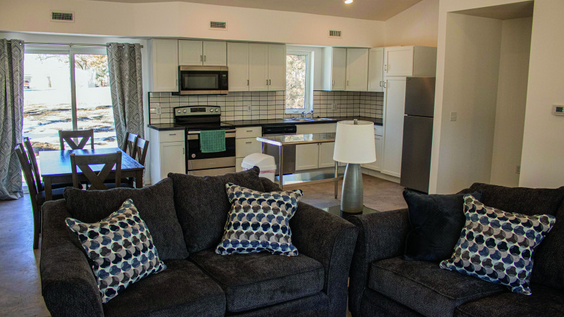
Houses built in rural Kansas help local economies
By GREG DOERING
Kansas Living
The state song of Kansas begins “Oh, give me a home …” and calls to the state’s frontier days, when the land served as a beacon of hope for thousands seeking new lives, land of their own and, of course, a place to call home.
In 1871, Brewster M. Higley was enticed by the prospect of free land for a homestead in Smith County. He settled on a site near West Beaver Creek, eventually penning the poem that became widely known as the song “Home on the Range” along the creekbank. Higley, along with some help from his friends, built a one-room cabin a year later.
While Higley’s poem probably served as a wish for a frontier life that no longer existed, with most buffalo, deer and antelope pushed out by settlers, the opening verse still rings true for Kansans today searching for home. The only difference is, residents might face more obstacles to finding a home, especially in rural areas, than Higley had building a shelter nearly 150 years ago.
Without housing, small cities and towns struggle to attract professionals in education, health care, manufacturing and food processing. Fixing rural housing isn’t just an issue for the cities and towns afflicted with a shortage; rather, it’s about unleashing the state’s full economic potential.
How to make rural housing accessible
Stafford County economic development director Carolyn Dunn knows how important access to housing is for companies eyeing a new location, and she knows just how difficult it can be to build even a single home to begin addressing a shortage of quality, affordable accommodations. She says housing is the No. 1 priority for her agency right now.
Part of the problem can be traced back to what happened about two decades ago. Or rather what didn’t happen in the county of just over 4,000 about 90 minutes north and west of Wichita.
“We’ve had entire years, especially in the 1990s and early 2000s, when there wasn’t a single house built in the county,” Dunn says. “A lot of those 20-year-old houses would be very desirable. We just don’t have them.”
The median age of a home in Stafford County is 70 years, with the average age about a decade older.
“Part of our problem is we don’t have those houses that are not brand new but also not so old they are needing significant rebuilding,” Dunn says.
The challenges of rural housing
Rural housing has posed a challenge for several years — different cities have tried a variety of solutions from giving away free land to offering cash for people willing to build new homes — with a mixed result.
For Stafford County, even a $25,000 stipend toward a new home wasn’t enough to incentivize much construction, and most of the money reserved for the program wasn’t spent.
“We have got to find a way to build housing that’s affordable for the kind of income we have here,” Dunn says. “The median household income here is $45,000 a year. That’s too high to be considered low-income and qualify for subsidized housing. It’s also not high enough to qualify for much of a mortgage.”
Instead of relying on individuals to come forward, Dunn opted to take control of building projects herself after a chance encounter in 2018 with Michael Gibson, an associate professor in Kansas State University’s College of Architecture.
“We were both interested in seeing how to move the needle on this,” Dunn says. “He was also receptive to the idea that rural areas aren’t getting much attention.”
Stafford County was selected as a project for one of Gibson’s classes in 2019, in which students conducted visits, tours and focus groups before working on home designs that could be built near a $100,000 price point.

Work on the first home didn’t start until July 2020 and it was finished about a year later after COVID-19 delayed progress.
“We had really optimistic projections of what things would cost under normal circumstances, but material costs did go up and that affected things to a degree,” Dunn says. “K-State brought some money to the table, and we had a $50,000 grant from the Kansas Housing Resources Corporation. Theoretically, we should have been able to cover most of the cost between those two but that wasn’t the case.”
Dunn says they were able to cover the shortfall with a grant from a private foundation, and the overall experience was positive and involved a lot of learning.
Making rural housing affordable
The home’s design comes with several tradeoffs to make it more affordable. There’s no basement or attached garage. The bedrooms are smaller to allow for a larger living area capable of hosting family functions or parties.

Stafford County is already putting that education to use, having just finished a second home with three others under construction across the county. In all, the county’s economic development office plans to build 10 new homes.
“They put a lot of thought into a layout that’s very livable. We had an open house with probably 30 people and they all fit into the living room,” she says. “It’s not going to be the house for everyone. It just has to be a fit for some and that’s progress.”
Rural housing projects and their limitations
Dunn says most of the money available for housing projects like those undertaken by Stafford County are targeted to low-income residents because that’s where the federal government allocates most of its grant money.
Rent on the new homes is income-based and will be in the range of $500 to $550 per month, or about half of what the government formula would allow. But, Dunn says, that raised the other issue Stafford County faces in trying to develop new housing or even preserve the existing stock.
“A lot of people would consider a reasonable rental rate here $400 per month,” she says. “That’s part of the challenge. At $400 per month, there’s not enough income there to maintain housing well or entice investors. In some ways, cheap housing is our enemy.”
Dunn’s hope is once all 10 homes are built and occupied, her agency will have the cash flow to start building so-called workforce housing.
“We’re trying to find a way to build housing that’s affordable to people making $50,000 to $90,000,” she says. “That could be a couple of teachers. It could be people who work at grain elevators or feedlots. We can’t wait another 20 years to get that housing here.”
Growing funds for expansion of rural housing
Trisha Purdon is familiar with the struggles in Stafford County and has heard similar stories across the state as the director of Kansas’ Office of Rural Prosperity. She’s hopeful a recently completed survey of the state’s housing needs will lead to more investment.
“If you have a full analysis of what’s needed in these communities for housing, you can show a developer or business interested in building houses the potential benefits,” Purdon says.
One of Purdon’s current projects is turning her agency into a one-stop shop for advice on how to get projects done, whether that’s pointing people to grant opportunities or helping navigate the red tape associated with existing programs.
“I worked in economic development for about a decade before moving into this position, and even I had no idea who I needed to talk to for the rehab of a downtown building or how to go about getting federal grants,” she says. “If I’ve been doing this for 10 years and I don’t know, how is the local volunteer dabbling in economic development in a small town going to do it?”
Another piece of “low-hanging fruit” Purdon has identified is closing the gap between what it costs to build a home in a rural area compared to what a bank is willing to lend on a property. Known as the appraisal gap, Purdon says states like Iowa and Nebraska have successfully implemented programs to offset it.
How local communities impact rural housing issues
Purdon says neither the state nor federal government can be wholly responsible for solving the rural housing puzzle. Instead, it will be cities and regions coming together to find the best solutions for their individual problems.
Housing down payment
In early April, the Kansas legislature approved spending approximately $100 million on housing incentives, including significant investments in rural housing.
Included in the spending package is $40 million to spur moderate-income housing programs. An additional $20 million is targeted to a revolving loan fund dedicated specifically to rural housing. These measures represent the bulk of the spending that will occur over the next several years and be multiplied many times over by private investment.
The funding comes from the state’s general fund and federal COVID-19 relief money. Kansas Farm Bureau (KFB), along with more than a dozen other organizations, supported these spending measures as a first step to address the rural housing shortage in Kansas and to help facilitate economic development across the state.
"I’ve heard from people across the state how a lack of housing is holding rural areas back from growing their local economies. I commend our legislators and Gov. Laura Kelly for taking advantage of the state’s extraordinary budget surplus to make a significant investment to improve the lives of Kansans and lower a barrier to rural economic growth." - KFB President Rich Felts





